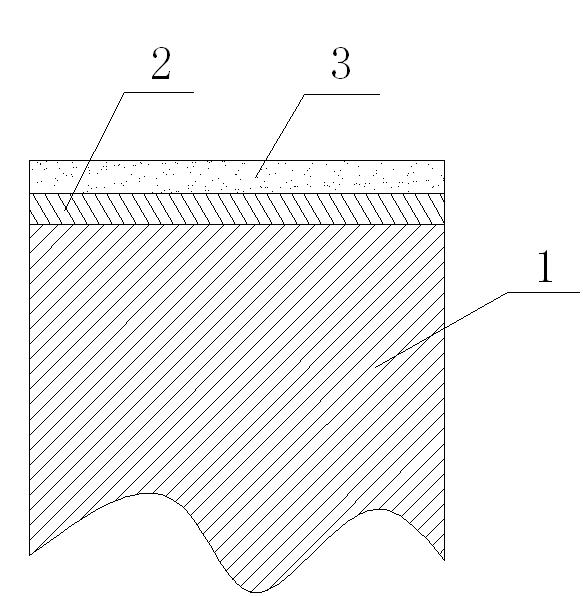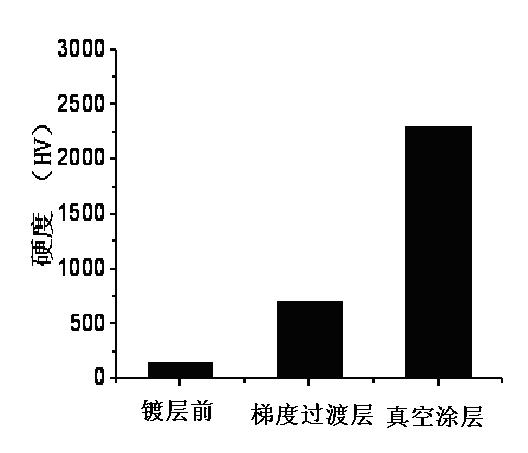Surface compound strengthening process for aluminum alloy material
A technology of aluminum alloy material and surface composite, applied in metal material coating process, superimposed layer plating, coating and other directions, can solve the problems of low hardness, poor bonding strength, poor wear resistance, etc., to achieve wear resistance Good, high hardness and wear resistance, high bonding strength effect
- Summary
- Abstract
- Description
- Claims
- Application Information
AI Technical Summary
Problems solved by technology
Method used
Image
Examples
Embodiment 1
[0023] In the first step, the thickness of aluminum and aluminum alloy surface plating is 2μm Ni coating:
[0024] The process flow of electroplating Ni layer: mechanical polishing→gasoline or carbon tetrachloride degreasing→installation→chemical degreasing (alkaline etching process)→descale or emit light in 1:1 nitric acid and 5% hydrofluoric acid solution ( Acid etching process)→Washing→Activation→Washing→Nickel plating→Washing→Drying.
[0025] (1) Alkali etching process: Na 2 CO 3 30g / L, Na 3 PO 4 30g / L, additive 2-4 g / L, OP-10 emulsifier 0.5-1 mL / L, temperature 75-85℃, time 30-60s;
[0026] (2) Acid etching process: HNO 3 3 parts, 1 part HF, a small amount of water, temperature room temperature, time 20-40s;
[0027] (3) Nickel electroplating solution formula and process parameters (the name should be one-to-one correspondence with the above process flow, and the terms should be consistent): nickel sulfate (NiSO 4 ·7H 2 O) 250g / L, nickel chloride (NiCl 2 ·6H 2 ...
Embodiment 2
[0032] Step 1: Electroless plating on the surface of aluminum and aluminum alloy with a thickness of 10 μm Ni plating.
[0033] In the second step, the Ni-plated aluminum alloy mold is cleaned by an ultrasonic cleaning line to remove the chemical plating residue, and then placed in a constant temperature drying oven at a constant temperature of 75°C for 2 hours.
[0034] The third step: Hollow cathode ion plating deposition CrN coating process and parameters:
[0035] Fix the dried aluminum alloy mold on the bracket, put it into the hollow cathode coating machine, put the Cr coating material in the crucible of the coating machine, adjust the rotation speed of the workpiece support to 6-10 rpm, and pump to the background vacuum of 2.5-3.0×10- 3 Pa, turn on the heater at the same time, raise the temperature to 200-300°C; open the Ar gas flow valve, adjust the vacuum chamber to about 0.5-1 Pa, apply a negative bias voltage of 300-800 V to the substrate, and perform glow sputteri...
Embodiment 3
[0037] The first step: the thickness of electroless plating on the surface of aluminum and aluminum alloy is 4 μm Ni-P coating.
[0038] In the second step, the aluminum alloy mold treated with Ni-P is cleaned by an ultrasonic cleaning line to remove the chemical plating residue, and then put into a constant temperature drying oven and baked at a constant temperature of 80°C for 1.5 hours.
[0039] The third step: two layers of TiN coatings were deposited by magnetron sputtering ion plating, the deposition temperature was 200° C., and the thickness of the two layers of TiN coatings was 4 μm.
[0040] The technical solutions of electroplating and electroless plating of the present invention are all known technologies, so no detailed description will be given. Multi-arc ion plating, hollow cathode ion plating, and magnetron sputtering ion plating also adopt the existing low deposition temperature (180-250°C) vacuum coating technology, and other technical solutions of the present...
PUM
| Property | Measurement | Unit |
|---|---|---|
| thickness | aaaaa | aaaaa |
| thickness | aaaaa | aaaaa |
| microhardness | aaaaa | aaaaa |
Abstract
Description
Claims
Application Information
 Login to View More
Login to View More - R&D
- Intellectual Property
- Life Sciences
- Materials
- Tech Scout
- Unparalleled Data Quality
- Higher Quality Content
- 60% Fewer Hallucinations
Browse by: Latest US Patents, China's latest patents, Technical Efficacy Thesaurus, Application Domain, Technology Topic, Popular Technical Reports.
© 2025 PatSnap. All rights reserved.Legal|Privacy policy|Modern Slavery Act Transparency Statement|Sitemap|About US| Contact US: help@patsnap.com


